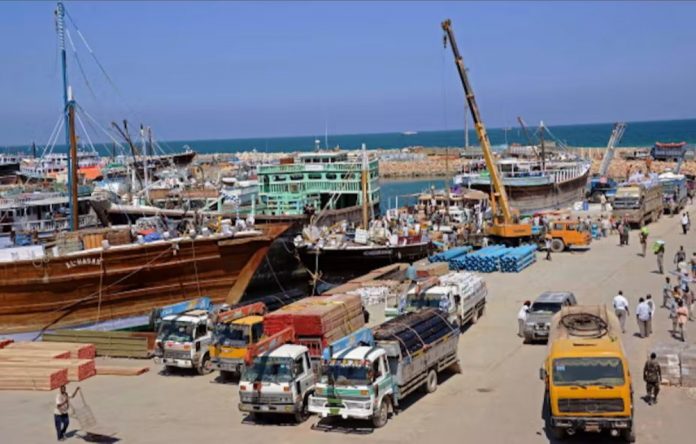The port city of Bosaso, located at the north-eastern corner of Somalia, provides a striking example of the interlinkage between security and infrastructure. The city benefited from the civil war that ravaged the southern parts of Somalia in the 1990s and 2000s. It developed into a booming trade centre. But increased violence in Bosaso has negatively affected international trade in the last decade. Security improvements and the recovery of other ports in Somalia and Somaliland have provided alternatives.
In July 2022, the Emirates-based Dubai Ports World (DP World), a global operator of ports and logistics, returned to Bosaso. The company had signed a concession agreement with the government in Puntland, a federal member state of Somalia, in 2017. But the plans to modernise the port were never realised.
DP World’s return has instigated optimism across the city, though numerous challenges still lie ahead.
Our research project is studying the Horn of Africa’s emerging port infrastructures and their impact on the everyday lives of people in cities.
Get news that’s free, independent and based on evidence.
Bosaso’s efforts to remain economically relevant will have implications for the relative independence that Puntland has achieved from the federal government in Mogadishu. An upgraded port could bolster citizens’ trust in the semi-autonomous government.
A lifeline for Puntland
The port of Bosaso is located on the Red Sea. Its development was tied to the beginning of the civil war in Somalia in the 1980s. Siad Barre, the military dictator who ruled the country from 1969 to 1991, rehabilitated a highway between Bosaso and central Somalia, and allowed Bosaso to operate the port duty-free. This was to appease his opponents in the north-east and to economically harm rising opposition in the north-west (now Somaliland).
Trading activities and property investments in Bosaso increased significantly after the Somali state collapsed in 1991. Bosaso City grew considerably in the early 1990s when it evolved into a prime destination for people who fled from violence in the southern parts of Somalia.
Among the immigrants were former political and business elites with clan affiliations to the north-east. Others were from the politically marginalised and harassed clans and minority groups of southern Somalia.
The closeness and historic shipping links between Bosaso and Yemen additionally pulled people to the city. Younger people looking for an option to escape poverty and a life full of risks moved to Bosaso to embark on Tahriib, the undocumented and dangerous migration across the Red Sea to the Gulf states and from there, if possible, further to Europe.
During the early 1990s, Bosaso had the only relatively safe port in Somalia. It became a major trade hub for livestock exports and consumer goods imports. This integrated Bosaso into an international trade network and linked the port to central Somalia and eastern Ethiopia.
New livestock quarantine stations were established, financed by Saudi Arabia and managed by a highly skilled labour force (mainly from Egypt). This was to avoid economically damaging livestock bans from Saudi Arabia on the basis of animal health.
Income from the flourishing seaport supported the establishment of the semi-autonomous region of Puntland in 1998.
Port in decline
But Bosaso is currently struggling to maintain its economic relevance. This has political implications for the relative independence that Puntland has achieved from the Somali federal government.
International trade activities have been declining during the last decade. Since 2015, the war in Yemen has interrupted established trade routes. Additionally, the city has faced threats from Islamist insurgents, prominently Al-Shabaab and the Islamic State in Somalia.
The concession agreement with DP World’s subsidiary P&O Ports in 2017 added further layers of insecurity. Local groups criticised the “sell-out” of the port to a foreign country, while business groups feared that a rise in port fees would have a negative impact on local trade.
Disputes among the Puntland leadership, and disagreements between Puntland and P&O Ports, delayed the planned modernisation. P&O eventually left Bosaso in 2019 after its port manager was killed by gunmen, an attack for which al-Shabaab claimed responsibility.
These developments stood in contrast to security improvements in southern Somalia. These were visible in the reopening of Mogadishu’s seaport, which has been managed by a Turkish company since 2014. Competition increased further with the DP World-driven modernisation of the port in Berbera in Somaliland.
Bosaso is not able to compete with the much larger multi-purpose ports in Berbera and Mogadishu. The two ports are fitted with container terminals and furnished with modern equipment. Bosaso, instead, has had a crucial position in a more informal overseas trade.
The ongoing transformation of global supply chains, with circulation increasingly relying on cranes and containers, detaches Bosaso from important trade networks. For example, containerised ports import goods directly from producing countries like China, while Bosaso relies on transshipment through intermediary ports in Yemen, Oman or elsewhere.
These developments have political implications. Many Bosaso residents attribute the port’s decline to leadership failure. A port official explained in an interview in August 2022:
[pullquote]The port has been neglected by all Puntland leaders. There was no investment provided to the port since 1991. The port is about to be relegated to irrelevance.[/pullquote]
At a crossroads
The modernisation of the port is critical for Puntland. An upgraded port will ensure Puntland keeps a significant position within the fragmented political landscape of Somalia. It will also prevent traders from looking for alternative outlets.
Multiple challenges, among them security considerations, lie ahead. The relations between Puntland and the government in Mogadishu, as well as disagreements within the Puntland leadership, are crucial. In short, Bosaso is at a crossroads and faces a defining moment for its political and economic future.
By Mohamed Hassan
Mohamed Hassan Ibrahim, a research consultant in the port infrastructure project, is a lead contributor and conducted most of the research for this article.
The Conversation





























